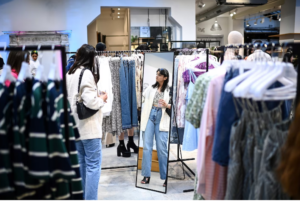In a world dominated by fast fashion, where trends come and go in the blink of an eye, the concept of buying clothes to last can seem like a relic. However, the environmental impact and ethical concerns surrounding the fashion industry, coupled with the desire for a more meaningful wardrobe, have sparked a reevaluation of the way we approach clothing consumption.

A decade ago, fashion writer Derek Guy interviewed a Parisian student named Brian, whose timeless and sophisticated wardrobe remained relevant even ten years later. Brian’s approach to fashion, characterized by a minimalist yet elegant collection, showcased the potential longevity of well-chosen garments. This philosophy challenges the prevailing notion that one needs to invest in high-end designer brands to achieve such durability, emphasizing that quality pieces can be found in more accessible stores like Uniqlo, J.Crew, Target, or Gap.
Fast fashion, with its rapid design-to-rack timeline and disposable nature, has contributed to the staggering amount of textile waste. In 2018 alone, 11.3 million tons of textiles ended up in landfills in the United States, prompting a critical examination of our clothing consumption habits.
As winter approaches and the temptation to refresh our wardrobes grows, it’s essential to reconsider the value of each purchase. Rather than succumbing to the allure of a new sweater or a discounted item, it’s worth asking whether the garment will hold significance beyond a fleeting fashion moment.
Planned Obsolescence and Psychological Obsolescence
The concept of planned obsolescence, dating back to the Great Depression, involved intentionally making products less durable to stimulate more frequent replacements. Over time, this strategy evolved into “psychological obsolescence,” where consumers are persuaded to discard perfectly functional items for newer, trendier versions with minimal changes.
Fashion has mastered psychological obsolescence, convincing consumers to abandon clothes long before their physical lifespan ends. The desirability of fashion is often dictated by external factors—designers, retailers, or peer influence—leading to a perpetual cycle of changing trends and consumer dissatisfaction.
To counteract this cycle, Jonathan Chapman, a professor at Carnegie Mellon University’s School of Design, introduced the concept of emotional durability. He argues that possessions, especially clothes, should be viewed as extensions of our identities and values. By recognizing the emotional value in our items, fashion can transcend trends and become timeless.
Building an Emotionally Durable Wardrobe
To construct a wardrobe that withstands the test of time, it’s crucial to move beyond the superficial appeal of trends and focus on personal meaning. The Contentedness Thread, an online community where individuals celebrate ordinary yet cherished garments, exemplifies the emotional connection people can have with their clothes.
Investing in emotionally durable clothing involves looking beyond price tags and considering the long-term value a piece holds for you. High fashion and exclusive designers are not the sole paths to emotional durability. Discovering what resonates with your personal style, irrespective of price, is equally valid.
Recognizing quality and value is essential in this journey. While the common advice is to “buy the best you can afford,” it’s crucial to understand that “best” is subjective. Quality can be found at various price points, especially with the rise of online platforms for used and vintage clothing.
Developing a personal style that combines elements from different eras allows for the creation of unique, timeless looks. Unlike previous decades, where a single, recognizable style defined each generation, the current cultural landscape embraces diversity, enabling individuals to craft styles that endure.
Resisting the temptation of impulsive purchases, especially driven by discounts, is vital. Buying something solely because it’s cheap, rather than genuinely loving it, often leads to disinterest once the initial excitement fades. Setting a price threshold for each item encourages thoughtful consideration, turning the purchase into an investment rather than a momentary thrill.
In the pursuit of a more sustainable and meaningful wardrobe, the shift from the mere consumption of clothing to a thoughtful, emotionally driven approach becomes imperative. Ultimately, it’s not just about changing clothes; it’s about changing the way we perceive and connect with them. As the saying goes, “The clothes make the man,” but perhaps, in the context of emotional durability, “The man makes the clothes.”


